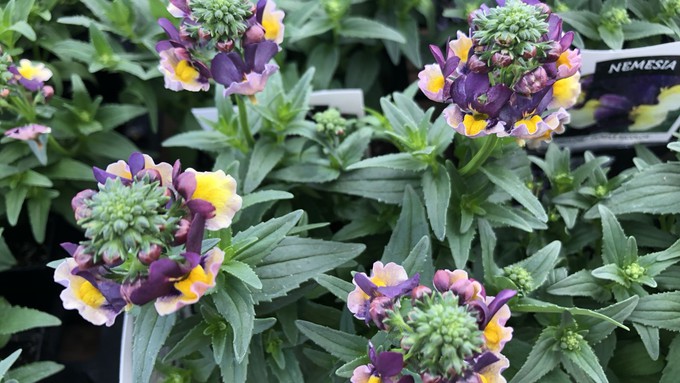
More heavy rain is on the way; watch out for gusty winds

Nemesias are easy-care annuals that come in a variety of colors. Plant them this month (during a break from the rains) for color through spring. Kathy Morrison
Keep your umbrella handy – and tie down the patio furniture. We’re in for some wild winter weather.
A new, stronger storm system is expected to arrive in Sacramento late Saturday night or early Sunday.
According to the National Weather Service, heavy rain is expected in the Sacramento Valley and Sierra snow as low as the 3,000-foot elevation. The storm also brings strong gusty winds, especially south of Interstate 80.
Thunderstorms and showers will continue through Wednesday before clearing later in the week, says the weather service. This new storm could dump as much as 2.5 inches on Sacramento, says the weather service. February in Sacramento averages 3.6 inches.
On track for a “normal” water year, Sacramento already received a good share of rain this week including 0.42 inches on Jan. 31. That brought January’s rain total to 3.66 inches – just above average for that month.
While it’s raining, stay dry indoors and plan for sunny gardening days to come. Spring will be here before you know it.
* Avoid walking on or digging in soggy soil; wet ground compacts easily, squeezing out vital air spaces.
* Take some time to review your plans for spring and summer planting. Sort your seed packets and shop for more as needed. Most seeds retain their vitality for at least three years.
* When the rain takes a break, finish winter chores. Prune, prune, prune! Your roses are already coming out of dormancy (or may have never stopped blooming). Strip off old foliage and clean up debris under bushes.
* Clean up fallen branches and other debris knocked down by the storm. Make sure gutters are kept clear.
* Feed spring-blooming shrubs and fall-planted perennials with slow-release fertilizer. Feed mature trees and shrubs after spring growth starts.
* Remove aphids from blooming bulbs with a strong spray of water or insecticidal soap.
* Fertilize strawberries and asparagus.
* During rainy weather, turn off the sprinklers. After a good soaking from winter storms, lawns and other landscaping can go at least a week without sprinklers.
* Take advantage of soft (not soggy) soil after the storm. Transplant or direct-seed several flowers, including snapdragon, candytuft, lilies, astilbe, larkspur, Shasta and painted daisies, stocks, bleeding heart and coral bells.
* In the vegetable garden, plant Jerusalem artichoke tubers, and strawberry and rhubarb roots.
* Transplant cabbage and its close cousins – broccoli, kale and Brussels sprouts – as well as lettuce (both loose leaf and head).
* Indoors, start peppers, tomatoes and eggplant from seed.
* Plant artichokes, asparagus and horseradish from root divisions.
* Plant potatoes from tubers and onions from sets (small bulbs). The onions will sprout quickly and can be used as green onions in March.
* From seed, plant beets, chard, lettuce, mustard, peas, radishes and turnips.
* Spring annuals are showing up in nurseries, but wait until the weather warms up a bit before planting. Instead, set out flowering perennials such as columbine and delphinium.
* Plant summer-flowering bulbs including cannas, calla lilies and gladiolus.
Comments
0 comments have been posted.Sacramento Digs Gardening to your inbox.
Sites We Like
Garden Checklist for week of Nov. 3
November still offers good weather for fall planting:
* If you haven't already, it's time to clean up the remains of summer. Pull faded annuals and vegetables. Prune dead or broken branches from trees.
* Now is the best time to plant most trees and shrubs. This gives them plenty of time for root development before spring growth. They also benefit from fall and winter rains.
* Set out cool-weather annuals such as pansies and snapdragons.
* Lettuce, cabbage and broccoli also can be planted now.
* Plant garlic and onions.
* Keep planting bulbs to spread out your spring bloom. Some possible suggestions: daffodils, crocuses, hyacinths, tulips, anemones and scillas.
* This is also a good time to seed wildflowers and plant such spring bloomers as sweet pea, sweet alyssum and bachelor buttons.
* Rake and compost leaves, but dispose of any diseased plant material. For example, if peach and nectarine trees showed signs of leaf curl this year, clean up under trees and dispose of those leaves instead of composting.
* Save dry stalks and seedpods from poppies and coneflowers for fall bouquets and holiday decorating.
* For holiday blooms indoors, plant paperwhite narcissus bulbs now. Fill a shallow bowl or dish with 2 inches of rocks or pebbles. Place bulbs in the dish with the root end nestled in the rocks. Add water until it just touches the bottom of the bulbs. Place the dish in a sunny window. Add water as needed.
* Give your azaleas, gardenias and camellias a boost with chelated iron.
* For larger blooms, pinch off some camellia buds.
* Prune non-flowering trees and shrubs while dormant.
* To help prevent leaf curl, apply a copper fungicide spray to peach and nectarine trees after they lose their leaves this month. Leaf curl, which shows up in the spring, is caused by a fungus that winters as spores on the limbs and around the tree in fallen leaves. Sprays are most effective now.